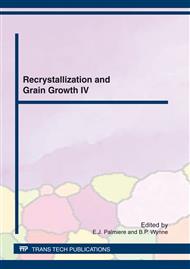p.380
p.387
p.393
p.399
p.407
p.415
p.416
p.427
p.437
Laser-Ultrasonic Austenite Grain Size Measurements in Low-Carbon Steels
Abstract:
Austenite grain size is an important microstructure parameter when processing steels as it provides the initial condition for the austenite decomposition that determines the final microstructure and thus properties of the steel. In low-carbon steels it is frequently difficult if not impossible to quantify the austenite grain size using conventional metallographic techniques. Laser-ultrasonics provides an attractive alternative to quantify the grain size in-situ during thermo-mechanical processing of a steel sample. The attenuation of the laser generated ultrasound wave is a function of the grain size. The present paper gives an overview on the state-of-the-art of this novel measurement technique. Using isothermal and non-isothermal grain growth tests in low-carbon steels the advantages and limitations of laser-ultrasonic measurements will be demonstrated. Further, their application for deformed samples will be presented to quantify austenite grain sizes during and after recrystallization. The in-situ measurements provide significantly new insights into the austenite microstructure evolution during thermo-mechanical processing of low-carbon steels. The implications on expediting the development of improved process models will be discussed.
Info:
Periodical:
Pages:
407-414
Citation:
Online since:
April 2012
Authors:
Price:
Сopyright:
© 2012 Trans Tech Publications Ltd. All Rights Reserved
Share:
Citation:


